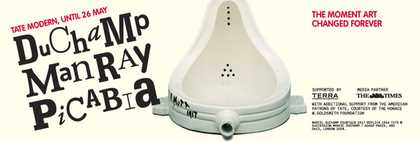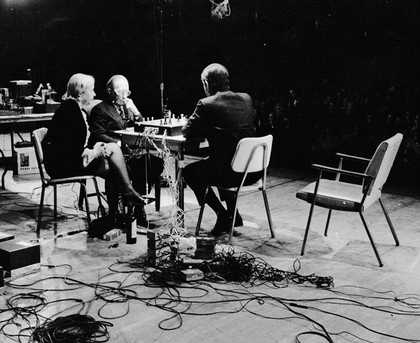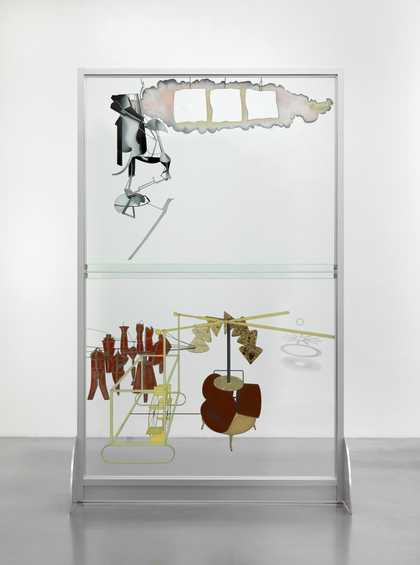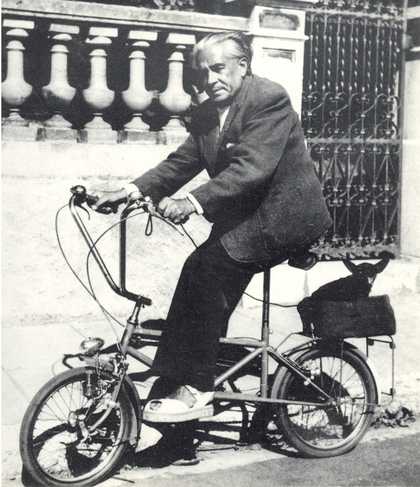Jacqueline Matisse Monnier on Duchamp and the Boîte-en-valise
There was something about Marcel Duchamp that people found attractive. My mother thought he had a charismatic allure. She told me a story that at one point Henry Miller had a crush on her, but he was rather vulgar and had no grace in what he was proposing, whereas Marcel just knew how to say and do things. He had a very light touch.
Marcel had had a very tense time in the 1940s, up until about 1952, when he had a romance with Maria Martins. He wanted her to abandon her life and come and live with him, but she returned to Brazil with her diplomat husband. However, he was in a good way when he was with my mother. They played chess. As long as he could get into his chess game, everything was fine. I remember that he was wonderful with us teenagers; very quiet and so easy to be with.
From 1961 to 1971 I worked on the construction of the Boîte-en-valise in batches of about twenty at a time. There were nearly 200 of them. They were very complicated because you had to put frames on the mini reproductions of his work. I had to fit it all exactly the way he had planned. He didn’t give many instructions about how to do it, so I had to use my good sense to assemble them. Marcel had met a wonderful Russian bookbinder and printer, Ilia Zdanevitch, who designed the wooden frames for them, which were an improvement on the early valises, some of which had been made in cardboard. I also got involved with Marcel in Hans Richter’s 1957 film 8 x 8: Chess Sonata in 8 Movements, the title referring to the 8 x 8 arrangement of squares on a chessboard. It was made from eight stories that followed one other – each filmed in a different place – and included people such as Max Ernst and his wife, Yves Tanguy, Jean Cocteau, Dorothea Tanning and Alexander Calder. In our scene we played chess characters: I was the white queen and Marcel the black king. It was very amusing to do it – it was more about adults having lots of fun than anything else.
T.J. Demos on Marcel Duchamp’s Cast Shadows 1918
Graphically provocative yet modestly scaled, Cast Shadows portrays dark enigmatic forms intertwining, suggesting something like a broken spider’s web. You can just make out the traces of the artist’s iconic readymades – part of the Bicycle Wheel and the hanging Hat Rack. Cast Shadows shows that the readymade, in which Duchamp famously transformed the mass-produced commodity into art, was about more than the attempt to expose the commercial status of artistic practice by showcasing art’s capitalist basis and the artist’s newly consumerist identity (Duchamp would simply buy his art in places such as department stores). It was also about more than revealing how aesthetic value was spreading promiscuously into the most banal of everyday objects – the urinal, hair comb and hat rack which Duchamp termed art – although he would explain that his readymades were chosen in a state of “visual indifference” and “complete anesthesia”. While this account is certainly compelling – and indeed the readymade has inspired numerous generations of artists, from Dada to conceptual art, to interrogate the commercialisation of art and the aestheticisation of everyday life – it is not the final word. For what goes unmentioned is the readymade’s transformative power, which reveals another side of Duchamp’s practice. For him, the readymade designation would also extend a “new thought” to a stultified object, releasing it from its common use and boring repetition – a urinal, for instance, could be thought of as a “fountain”. Going further, Cast Shadows projects this conceptual dislocation into visual terms, showing readymades as luminous ghosts caught in a snapshot during their process of becoming something else, so that they no longer appear to be the same. The challenge, as Duchamp indicated in one of his notes – notable for its resonance with philosopher Henri Bergson’s contemporaneous ideas concerning change – was to project an object that maintained its sense of likeness through time (i.e. an industrially produced commodity) into an open-ended process of “possibility”, thereby rendering the thing unrecognisable from one moment to the next. Duchamp produced the work while living in New York, after he had fled his native France, then in the grip of war, which is telling; for it demonstrates the surprising ethical commitment of his aesthetic experiment. He subverted conformity – of artistic conventions, the marketplace and nationalism alike – by generating creativity from within its very forms.
George Baker on Francis Picabia’s The Merry Widow 1921
There doesn’t seem to be much to this piece – a stained and desiccated expanse of canvas, an aging photograph, a pretty terrible drawing, a title and a signature in handwriting worthy of a child. And yet I hardly know where to begin. There is a lot of talk today about collaboration and collectivity in contemporary art. I know of few works of art as fully collaborative as this.
There is Picabia staring at us, smiling. And yet this self-image was produced for the artist by his friend Man Ray (and signed as such). Picabia copies Man Ray’s photograph in his drawing. He copies, in other words, an image of himself made by someone else. He no longer seems to be smiling. He places his drawing below, and the photograph above, in an arrangement that can only remind the viewer of the work of yet another artist – and another enigmatic self-portrait – The Bride Stripped Bare by Her Bachelors, Even (The Large Glass) by Marcel Duchamp. In the two-tiered Large Glass, photography had been imagined as producing all of the forms of the top domain of the “bride”, while mechanical drawing had been used to determine the forms of the zone of the “bachelors” below. So Picabia copies a photograph of himself by Man Ray in order to produce an image of himself that is then arranged in the format of a work by Duchamp. And he entitles the whole The Merry Widow. This title too refers to Duchamp, who in 1920 had produced a melancholic pendant to The Large Glass in the form of a dysfunctional French window called Fresh Widow. But actually that work was not made by Duchamp, but by a commissioned craftsman. And, in fact, it was not signed by him either, but by a female alter ego who would henceforth go by the name of Rrose Sélavy. And, to complicate matters even more, The Merry Widow as a title belongs to another source altogether, the comic opera from 1905 by Franz Lehar.
“If the work of another translates my dream,” Picabia once said, “then his work is mine.” He was divulging his secrets here. His work was based on the copy, on what Duchamp had for several years been calling the readymade. And yet The Merry Widow is not without its enigmas. It is, in fact, something like a rebus. For who or what is the widow, and why is she merry? Is the widow Picabia? The male-artist-as-woman was the very point of Duchamp’s alter ego Rrose Sélavy. Picabia similarly embraces a model of art making that is dead set against the potentially patriarchal values of mastery, originality and even the ownership of creative ideas.
I love the manner in which Duchamp, Picabia and Man Ray fed off each other’s work. They shared a language of their own invention; however, each could speak the language and it didn’t belong to any single one of them. To my knowledge, the intensity of such collaboration was without precedent in the history of art. It has rarely been equalled since. A collaboration metaphorised through “marriage” and through widows and brides; a communication between three male artists so radical that it imagined their own gender reversal. Art history has barely touched this. Little wonder. But look again at the art of Marcelle, Emmanuelle, Francine. Look again at Picabia smiling at us. Smiling like the Mona Lisa. Smiling like Francine.
Kim Knowles on René Clair and Francis Picabia’s film Entr’acte 1924
What is it that makes René Clair and Francis Picabia’s 1924 film Entr’acte remain so appealing? The answer can perhaps be found in its playful tone and comic absurdity, its collage-like construction and subversion of traditional narrative logic and its celebration of, to quote Picabia, “the desire to burst out laughing”. Written by Picabia with music by Eric Satie, Entr’acte was screened as part of a Dada event in the interval between the acts of Picabia’s interventionist ballet Relâche (which means “no performance”). Staged at the Théâtre des Champs-Élysées in Paris and only managing a twelve-night run before closing, the performance was wilfully subversive. At one point Satie and Picabia are said to have driven around the stage in a motor-scooter chair, “gleefully waving to the jeering, cheering crowd they had so magnificently ridiculed”.
In the opening sequences of Entr’acte a cannon enters, propelling itself on a Paris rooftop. Picabia and Satie jump into the screen in slow motion – the latter in a bowler hat and clutching an umbrella – and fire the cannon directly at the camera. This blatant act of Dadaist provocation is appropriately followed by a series of unrelated sequences, which include the hilarious image of dolls with inflating and deflating heads, a graceful ballerina shot from below who eventually turns out to be a bearded man and the unforgettable sight of Man Ray and Duchamp playing chess, only to be hosed down by an invisible perpetrator. Despite its frequently whimsical transitions, the film does demonstrate a certain amount of visual and thematic continuity. Water reappears as a hunter aims his rifle at an egg that bobs on top of a fountain. When he finally succeeds in hitting it and a dove emerges from the shell, he is in turn shot by Picabia, leading the viewer into a funeral-cum-slapstick chase sequence worthy of Mack Sennett’s Keystone Cops.
What is so interesting about Entr’acte is the combination of Picabia’s anarchistic personality with Clair’s fascination with film aesthetics and the creation of a purely cinematic rhythm. We get this in the second half of the piece where the viewer is taken on a breathtaking visual (and literal) rollercoaster ride, in which superimposition, split-screen, rapid camera movement and a spectacular use of montage come together to create a kind of cinematic exhilaration. Nowhere has the thrill of movement and speed been so effectively expressed. It is undoubtedly this scene that makes the film so enjoyable, even more so than the camel-led funeral procession, the bearded ballerina, the paper boat that sails across the Paris skyline, or the miniature Place de la Concorde that appears on Man Ray and Duchamp’s chessboard.





